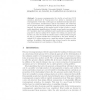192 search results - page 9 / 39 » Genome rearrangements with duplications |
RECOMB
2005
Springer
16 years 4 days ago
2005
Springer
We present data-analytic and statistical tools for studying rates of rearrangement of whole genomes and to assess the stability of these methods with changes in the level of resol...
RECOMB
2007
Springer
16 years 4 days ago
2007
Springer
A centromere is a special region in the chromosome that plays a vital role during cell division. Every new chromosome created by a genome rearrangement event must have a centromere...
BMCBI
2006
14 years 12 months ago
2006
Background: Analysis of genomes evolving via block-interchange events leads to a combinatorial problem of sorting by block-interchanges, which has been studied recently to evaluat...
107
click to vote
RECOMB
2009
Springer
15 years 6 months ago
2009
Springer
In genome rearrangements, the double cut and join (DCJ) operation, introduced by Yancopoulos et al., allows to represent most rearrangement events that could happen in multichromos...
RECOMB
2008
Springer
16 years 4 days ago
2008
Springer
Here we identify duplicated genes in five mammalian genomes and classify these duplicates based on the mechanisms by which they were generated. Retrotransposition accounts for at l...

